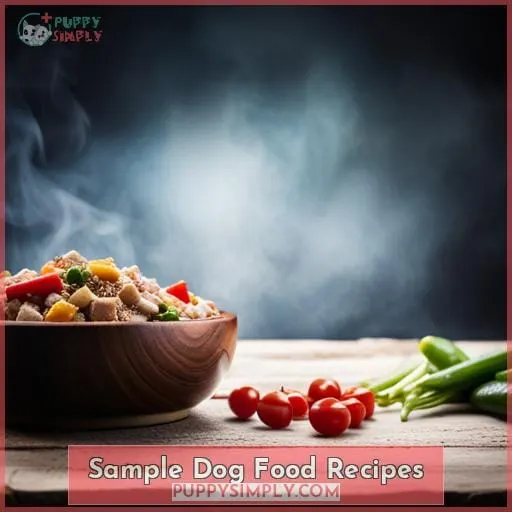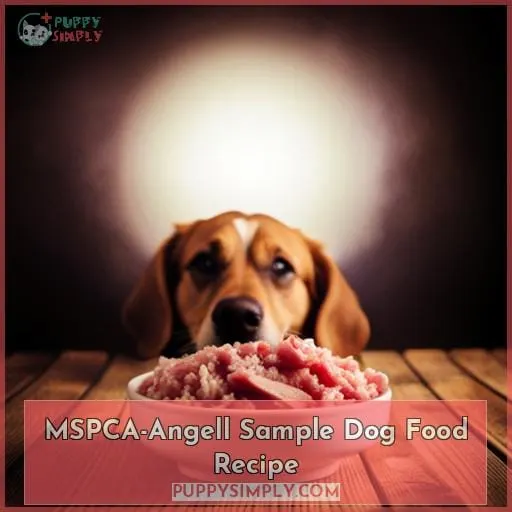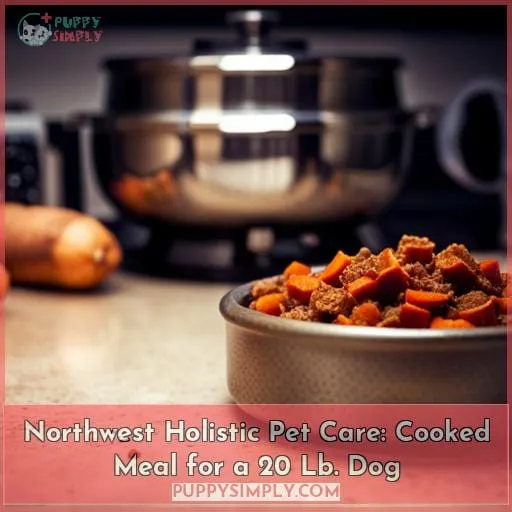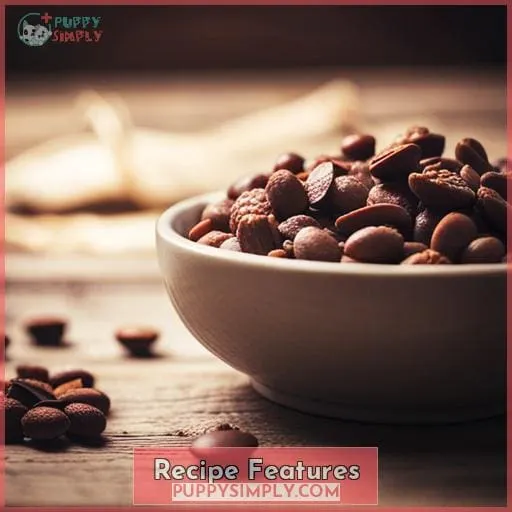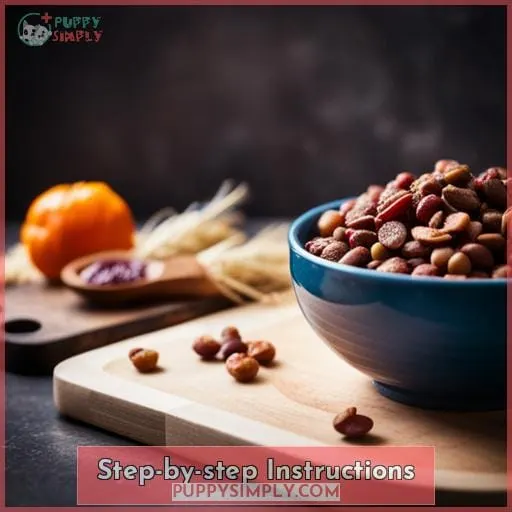This site is supported by our readers. We may earn a commission, at no cost to you, if you purchase through links.
 Imagine the joy on your furry friend’s face as they gobble up a delicious, homemade meal made just for them.
Imagine the joy on your furry friend’s face as they gobble up a delicious, homemade meal made just for them.
With these nutritious and delicious homemade dog food recipes, you can provide your canine companion with the best ingredients and flavors that will keep them happy and healthy.
Say goodbye to store-bought options filled with unknown additives!
Take control of what goes into your dog’s bowl and give them a dining experience fit for royalty.
Table Of Contents
- Key Takeaways
- Should You Feed a Homemade Diet?
- Proper Nutrition for Dogs
- What to Watch for When Feeding Homemade Dog Food
- How to Prepare Homemade Food for Dogs
- Sample Dog Food Recipes
- MSPCA-Angell Sample Dog Food Recipe
- Northwest Holistic Pet Care: Cooked Meal for a 20 Lb. Dog
- Recipe Features
- Step-by-step Instructions
- Frequently Asked Questions (FAQs)
- Can I feed my dog a homemade diet without consulting a veterinarian?
- What are some common signs of sensitivity or illness that I should watch for when feeding my dog homemade food?
- Are there any specific dietary supplements that I should add to my dog’s homemade food?
- How long can I store homemade dog food in the freezer?
- Are there any safety precautions I should take when preparing homemade dog food?
- Conclusion
Key Takeaways
- Greater control over ingredients & quality
- Consult with a veterinarian for guidance
- Monitor the dog’s digestion and look out for signs of sensitivity or illness
- Follow proper storage guidelines to maintain freshness & safety
Should You Feed a Homemade Diet?
If you’re considering feeding your dog a homemade diet, it’s important to weigh the benefits and considerations before making a decision.
One of the main benefits is that it allows for greater control over the ingredients and quality of your dog’s meals. You can choose high-quality protein sources, include specific vegetables or grains based on their nutritional needs, and avoid potentially harmful additives found in commercial dog food.
However, there are also some considerations to keep in mind. Homemade diets require more time commitment for preparation compared to simply buying commercial options off the shelf. It may also be necessary to consult with a veterinarian or canine nutritionist for guidance on ensuring proper balance and meeting all of your furry friend’s nutritional requirements.
When deciding between homemade vs commercial options, it’s crucial not only to consider health benefits but also factors such as affordability, convenience, and availability. Consulting with veterinarians about dietary changes will help ensure safety while providing optimal nutrition through carefully chosen recipes.
Overall, dog owners have increasingly embraced preparing homecooked meals as they offer an opportunity to exercise full control over what goes into their pets’ bowls. However, to guarantee complete balanced nutrition, it would be best practice consulting professionals in veterinary care as part of implementing the strategy for homemade food.
As long as they are prepared carefully, homemade meals should provide health benefits and nutritional considerations comparable to commercial options.
Proper Nutrition for Dogs
When preparing homemade dog food, it’s important to ensure proper nutrition for your furry friend.
- Balanced diets: Dogs require a well-rounded diet that includes protein, carbohydrates, fat, and essential nutrients.
- Nutrient percentages: A balanced dog food diet typically consists of 50% protein, 25% vegetables, and 25% grains. These ratios can be adjusted based on your dog’s needs.
- Dietary considerations: Take into account any specific dietary needs or health issues your dog may have when selecting ingredients for their meals.
- Homemade ingredients: Using fresh and unprocessed ingredients ensures the highest quality nutrition for your pet.
- Vet consultations: It’s crucial to consult with a veterinarian before making any significant changes to your dog’s diet.
By following these guidelines and monitoring homemade dog food recipes closely, you can provide a balanced and nutritious meal plan tailored specifically for your beloved canine companion. Proper nutrition plays a vital role in promoting their overall health and well-being while giving you the satisfaction of knowing you’re providing them with optimal care.
What to Watch for When Feeding Homemade Dog Food
When transitioning your dog to a homemade diet, it’s important to closely monitor their health and well-being.
- Observe any changes in weight or body condition.
- Be alert for signs of sensitivity or illness such as vomiting or diarrhea.
- Keep records of your dog’s progress.
- Consult with a veterinarian if needed for guidance on adjusting the diet accordingly.
Transitioning to Homemade Food
As you transition your dog to a homemade diet, it’s important to closely monitor their health and make any necessary adjustments along the way.
- Gradually introduce homemade food by mixing it with their current diet.
- Monitor your dog’s digestion and look out for any signs of sensitivity or illness.
- Involve a veterinarian in the process to ensure your dog’s nutritional needs are being met.
| Transitioning Tips | Health Monitoring | Veterinarian Involvement |
|---|
Monitoring Your Dog’s Health
To ensure the well-being of your dog, closely monitor their health when transitioning to a homemade diet.
Keep an eye on any changes in weight or body condition and record them for reference.
Watch out for signs of sensitivity or illness such as vomiting or diarrhea.
If necessary, consult with a veterinarian who can guide you in making dietary adjustments and provide professional advice throughout the process.
Your dog’s health should always be a top priority when feeding homemade food.
Involvement of a Veterinarian
To ensure the well-being of your furry friend, involve a veterinarian when feeding homemade dog food.
- Vet consultation: Seek professional guidance to create a balanced and nutritious diet for your dog.
- Health monitoring: Regularly monitor your dog’s weight, body condition, and overall health.
- Dietary adjustments: Work with the vet to make any necessary changes based on your dog’s specific needs or health conditions.
- Homemade food safety: Ensure that homemade meals are prepared safely to prevent bacterial contamination or nutrient deficiencies.
How to Prepare Homemade Food for Dogs
To prepare homemade food for your dog, start by gathering the necessary equipment such as:
- A food scale
- A food processor
- Pots
- Containers
Next, carefully select fresh and unprocessed ingredients to ensure optimal nutrition.
Accurate measurement of ingredients using a food scale is important for proper portioning.
Lastly, follow proper storage guidelines to maintain the freshness and safety of the homemade dog food.
Gathering Equipment
To prepare homemade food for your dog, you’ll need to gather the necessary equipment.
Equipment selection is important to ensure that you can properly measure and store the ingredients for your homemade recipe.
A food scale will help with accurate measurement, while a food processor can be useful for processing ingredients.
Additionally, having pots and containers for cooking and storage is essential.
Make sure to create a clean and dog-safe area in your kitchen when preparing the meals.
Selecting Ingredients
First, gather fresh and unprocessed ingredients to ensure a nutritious homemade meal for your dog.
Selecting high-quality ingredients is essential for providing balanced and healthy dog food. Look for lean protein sources such as meat or fish, vegetables rich in vitamins and minerals, and whole grains like brown rice or oats.
Ensure a dog-safe kitchen by keeping harmful foods out of reach.
Accurate measurement of ingredients using a food scale guarantees the right proportions in your homemade dog food recipe.
Finally, proper storage guidelines should be followed to maintain freshness and prevent spoilage of the prepared meals.
Proper Measurement and Storage
When preparing homemade dog food, it’s important to use proper measurement and storage techniques to ensure the safety and nutritional value of your furry friend’s meals.
To achieve this, consider the following tips:
- Measure ingredients accurately for nutrient density
- Store homemade dog food in freezer-safe containers or bags
- Plan portion sizes according to your dog’s caloric needs
By adhering to these guidelines, you can maintain a healthy feeding schedule and provide nutritious meals for your beloved pet.
Sample Dog Food Recipes
In the article titled ‘Homemade Dog Food Recipes: Nutritious and Delicious’, let’s explore some sample dog food recipes that you can try for your furry friend.
Making homemade meals for your dog ensures they receive a nutrient-dense and balanced diet customized to their specific needs. These easy-to-follow recipes provide healthy options that are safe and nutritious.
One sample recipe is the MSPCA-Angell Sample Dog Food Recipe, which includes detailed instructions using a dietary gram scale. It emphasizes proper measurement of ingredients to ensure accuracy in providing a well-balanced meal for your pet.
This recipe also highlights the importance of monitoring your dog’s weight and making adjustments as needed.
Another option is the Northwest Holistic Pet Care Cooked Meal for a 20 lb. Dog, which features ingredients with various benefits tailored specifically to address certain health conditions or concerns in dogs.
The directions provided allow you to prepare this cooked meal easily while ensuring all necessary nutrients are included.
By following these sample dog food recipes, you can create delicious homemade meals that meet all nutritional requirements while giving you peace of mind knowing exactly what goes into each dish prepared with love for your loyal companion.
MSPCA-Angell Sample Dog Food Recipe
Now, let’s take a closer look at the MSPCA-Angell Sample Dog Food Recipe.
This recipe provides detailed instructions on how to prepare homemade dog food using a dietary gram scale for accurate measurements. It emphasizes the importance of monitoring your dog’s weight and making necessary adjustments to ensure their nutrition needs are met.
By following this recipe and keeping an eye on your dog’s well-being, you can provide them with a nutritious homemade diet tailored to their specific needs.
Detailed Recipe and Preparation Instructions
To prepare the MSPCA-Angell sample dog food recipe, you’ll need to gather the necessary ingredients and follow the detailed instructions provided. This recipe offers nutritional value and health benefits for your furry friend. It’s cost-effective compared to store-bought options and allows you to control the quality of ingredients.
The preparation process involves cooking brown rice, browning ground turkey with olive oil, adding vegetables like spinach, carrots, and zucchini along with cooked rice. After thoroughly heating this mixture, divide it into single servings labeled with dates before freezing for future use.
Monitoring Weight and Making Adjustments
To monitor your dog’s weight and make necessary adjustments, you can follow the MSPCA-Angell sample dog food recipe.
It’s important to keep a close eye on your furry friend’s weight to ensure they maintain their ideal weight and avoid any potential health issues. Pay attention to how often you feed them and monitor their food intake carefully.
If you notice any signs of weight gain or if your dog reaches a plateau in terms of their progress, it may be necessary to adjust the amount of food they’re receiving or modify the proportions of protein, fat, carbohydrates, and fiber in their homemade diet accordingly.
Northwest Holistic Pet Care: Cooked Meal for a 20 Lb. Dog
If you’re looking for a homemade dog food recipe specifically designed for a 20 lb.
Their cooked meal includes ground turkey as the protein source, along with vegetables like spinach, carrots, zucchini and peas to provide essential nutrients.
This recipe also emphasizes the importance of adding nutritional supplements to address specific health conditions in your furry friend.
Ingredients and Their Benefits
Continuing with the benefits of homemade dog food, let’s now explore the ingredients and their benefits in a cooked meal recipe designed for a 20 lb.
This recipe includes high-quality protein from ground turkey, which is essential for muscle development and repair.
Brown rice provides fiber and carbohydrates for energy, while olive oil adds healthy fats to support skin health.
Overall, this balanced meal offers essential nutrients like calcium and protein that are vital for your dog’s well-being.
Directions for Preparation
Now let’s dive into the directions for preparing a nutritious cooked meal for your 20 lb.
- Cook rice according to package instructions.
- Brown turkey in olive oil until fully cooked.
- Add vegetables (such as spinach, carrots, and zucchini) and cooked rice to the pan and heat until wilted.
- Ensure that the mixture is thoroughly heated and safe for consumption.
Once prepared, you can divide the batch into single servings, label them with the date they were made, and freeze them for future use. This recipe provides a balanced ratio of protein from turkey, vegetables like spinach and carrots,and grains from brown rice.
Homemade dog food isn’t only a healthy option but also convenient to make at home.
Important Notes and Nutritional Supplements
For optimal nutrition, it’s important to include key nutrient supplements in your homemade dog food recipe for a 20 lb.
- Calcium supplements are crucial for bone health.
- Vitamin A supplements support vision.
- Zinc supplements boost the immune system.
- Probiotics promote gut health.
- Incorporating omega-3 fatty acids from sources like fish oil can benefit heart health.
By including these essential nutrients in your dog’s diet, you can ensure their overall well-being and vitality.
Recipe Features
When it comes to homemade dog food recipes, there are several key features that make them a popular choice among pet owners.
First and foremost, making your own dog food can be a cost-effective option compared to buying store-bought options.
Additionally, preparing homemade meals allows you complete control over the ingredients used and ensures high-quality nutrition tailored to address specific dietary needs or health issues your dog may have.
Cost-effectiveness of homemade dog food
Making homemade dog food is a cost-effective option for pet owners looking to provide nutritious and delicious meals for their furry friends.
- Cost savings compared to commercial options.
- Customization of ingredients based on your dog’s needs.
- Health benefits from nutrient-dense, fresh ingredients.
- Environmental sustainability by reducing packaging waste and carbon footprint of commercial production methods.
[ARTICLE CONTINUED]
Controlling ingredients and quality
By controlling the ingredients and quality of your homemade dog food, you can ensure that your furry friend receives a nutritious and delicious meal.
Homemade dog food allows for a variety of ingredients to be used, including fresh ones that are beneficial for their health. This gives you the opportunity to achieve nutritional balance in their diet while also addressing any specific dietary needs they may have.
Additionally, making your own dog food can be cost-effective and provides greater control over food safety compared to commercial options plagued by recalls.
Addressing specific dietary needs
To address your dog’s specific dietary needs, tailor homemade dog food recipes to their requirements.
Consider any allergies or sensitivities they may have and choose ingredients accordingly.
For weight loss management, opt for lean protein sources and limit carbohydrates.
Senior dogs may benefit from a diet rich in antioxidants and joint-supporting nutrients.
Pregnant dogs require additional calories and essential nutrients for proper development of puppies.
If your dog has an upset stomach, a bland diet with easily digestible ingredients can help alleviate symptoms.
Avoid grains if your pet has grain allergies or urinary tract infections in dogs are present.
Step-by-step Instructions
Now that you have learned about the benefits of homemade dog food and the nutritional requirements for dogs, it’s time to dive into step-by-step instructions on how to prepare these nutritious meals. In addition, we’ll discuss important considerations such as storage and provide more delicious recipes that your canine companion is sure to love.
By following these instructions and exploring different recipe options, you can ensure that your dog receives a balanced diet while enjoying tasty homemade meals.
Storage
When storing homemade dog food,
- Label each serving with the date and freeze it for future use.
- Freezing helps to maintain freshness and prevent spoilage.
- Use airtight containers or freezer bags to ensure no air or moisture can get in, which could lead to freezer burn.
- It’s important to portion out the food into appropriate sizes based on your dog’s needs.
- When ready to serve, defrost the desired portion in the refrigerator overnight before feeding it to your furry friend.
Following proper storage guidelines is essential for maintaining food safety and ensuring a balanced diet for your dog.
More Canine-approved Recipes
Now let’s explore some additional canine-approved recipes that you can easily prepare for your furry friend at home.
For a tasty chicken and rice dish, simply cook boneless chicken breasts and mix it with cooked brown rice.
If your dog prefers lamb, try making a meal with ground lamb and mashed sweet potatoes.
Another option is beef with steamed broccoli as the vegetable component.
Fish lovers will enjoy a recipe combining flaked fish with peas.
And if you want to celebrate your dog’s special day, consider making mini dog birthday cakes or refreshing dog popsicles using ingredients like pumpkin, carrots, peas, and baby spinach.
Frequently Asked Questions (FAQs)
Can I feed my dog a homemade diet without consulting a veterinarian?
Consulting a veterinarian is crucial when considering a homemade diet for your dog.
They’ll assess your dog’s specific needs and ensure the diet is balanced and nutritionally adequate, promoting their overall health and well-being.
What are some common signs of sensitivity or illness that I should watch for when feeding my dog homemade food?
Watch for signs of sensitivity or illness, like vomiting or diarrhea, when feeding your dog homemade food. These symptoms can indicate an adverse reaction to certain ingredients and may require adjustments to their diet.
Are there any specific dietary supplements that I should add to my dog’s homemade food?
To ensure your dog’s homemade food is nutritionally complete, consult with a veterinarian about adding specific dietary supplements.
They can recommend supplements like omega-3 fatty acids, probiotics, or joint support to enhance your dog’s health and well-being.
How long can I store homemade dog food in the freezer?
You can store homemade dog food in the freezer for up to three months.
Just make sure to:
- Label each serving with the date
- Thaw it properly before feeding it to your furry friend.
Are there any safety precautions I should take when preparing homemade dog food?
When preparing homemade dog food, it’s important to follow safety precautions.
- Wash your hands and utensils thoroughly before handling ingredients.
- Cook meat fully to kill any harmful bacteria, and
- Store leftovers in the refrigerator or freezer promptly to avoid spoilage.
Conclusion
Treat your furry friend to the best with these homemade dog food recipes.
By taking control of what goes into their bowl, you can ensure they receive nutritious and delicious meals that keep them happy and healthy.
Transitioning to homemade food may require monitoring your dog’s health and involving a veterinarian, but the benefits are worth it.
With proper preparation and storage, you can easily provide cost-effective meals tailored to your dog’s specific dietary needs.
Give your pup a dining experience fit for royalty with these homemade recipes.





